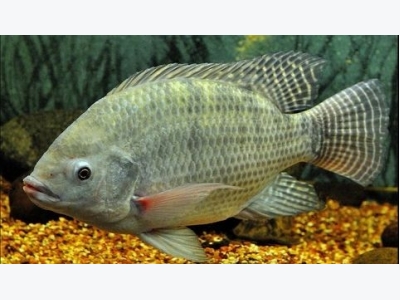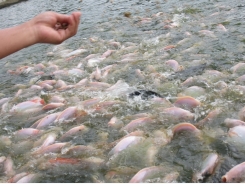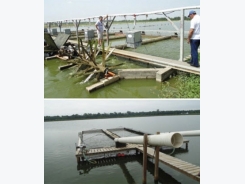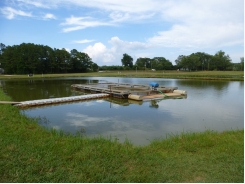A warning and an improved PCR detection method for tilapia lake virus (TiLV) disease

A warning and an improved PCR detection method for tilapia lake virus (TiLV) disease in Thai tilapia farms
Background
Tilapia lake virus (TiLV) is a novel RNA virus resembling Orthomyxovirus. It has been reported as a newly emerging virus that causes syncytial hepatitis of tilapia (SHT) in Israel, Ecuador, Colombia, and Egypt (Ferguson et al. 2014; Eyngor et al. 2014; Bacharach et al. 2016; Del-Pozo et al. 2017, Fathi et al. 2017). The disease caused massive mortality up to 90% in farmed tilapia and is considered to be a potential threat to global tilapia farming (Eyngor et al. 2014). In Thai tilapia farms, disease outbreaks have recently occurred associated with high cumulative mortalities (20-90%), and we have found that the diseased fish show typical histopathological features of SHT. Infection has been confirmed by transmission electron microscopy (TEM), in situ hybridization and high nucleotide sequence identity to TiLV from Israel (Dong et al. 2017). Our research progress was delayed by use of nested RT-PCR primer sequences previously published by Eyngor et al. (2014) together with detailed RT-PCR protocols later released by Tsofack et al. (2016). Our preliminary detection assays performed using the earlier report (Eyngor et al. 2014) with assumed PCR conditions (not specified in the publication) resulted in amplification of nonspecific fish genes. This probably resulted from the fact that 13-18 out of 20 nucleotides for the primer “Nested ext-2” matched fish genes. We, therefore, modified the nested RT-PCR protocols into a semi-nested RT-PCR by omitting the primer “Nested ext-2” to avoid false positive results.
The semi-nested RT-PCR protocol given below may be used freely for non-commercial applications to detect TiLV. Heavily-infected samples will generate 2 amplicon bands of 415 bp and 250 bp while lightly-infected samples will generate a single 250-bp amplicon band (Fig. 1). Since this is the first report of TiLV in Asia, the authors urge fish health laboratories in Asia to test for TiLV when abnormal mortality of tilapia occurs. Please contact Centex Shrimp (saengchan@biotec.or.th) to obtain a free positive control plasmid (pGEM-415_bp).
Detailed PCR protocol
| Primer name | Sequence (5’ to 3’) | Amplicon size (bp) | Reference |
| First RT-PCR | |||
| Nested ext-1 | TATGCAGTACTTTCCCTGCC | 415 | Eyngor et al. 2014, |
| ME1 | GTTGGGCACAAGGCATCCTA | ||
| Semi-nested PCR | |||
| 7450/150R/ME2 | TATCACGTGCGTACTCGTTCAGT | 250 | Eyngor et al. 2014, |
| ME1 | GTTGGGCACAAGGCATCCTA | Tsofack et al. 2016 |
Primer sequences
| Step | Reagents | Volume (μl) | Thermocycler parameters |
| First RT-PCR | 100-400 ng of total RNA | 1.5 | Reverse transcription |
| of total RNA 2X buffer | 12.5 | 50°C, 30 min | |
| 10 μM primer Nested ext-1 | 1 | Denaturation 94°C, 2 min | |
| 10 μM primer ME1 | 1 | 25 cycles of | |
| SuperScript One-Step | Denaturation 94°C, 30 s | ||
| RT/Platinum Taq mix (Invitrogen) | 0.5 | Annealing 60°C, 30 s | |
| Sterile water | 8.5 | Extension 72°C, 30 s | |
| Total reaction | 25 | Final 72°C, 5 min | |
| Semi-nested PCR | The first PCR product | 1 | Denaturation 94°C, 2 min |
| 10X buffer | 2 | 25 cycles of | |
| 10 mM dNTP | 0.4 | Denaturation 94°C, 30 s | |
| 10 μM primer 7450/150R/ME2 | 0.5 | Annealing 60°C, 30 s | |
| 10 μM primer ME1 | 0.5 | Extension 72°C, 30 s | |
| Taq DNA polymerase (5 units/μl) | 0.2 | Final 72°C, 5 min | |
| Sterile water | 15.4 | ||
| Total reaction | 20 |
Reaction conditions

Fig. 1 A sample agarose gel of TiLV detection from fish RNA extracts. Expected band sizes of 415 bp and 250 bp represent amplicons from the first and semi-nested PCR, respectively, with lanes marked ++ for a heavy infection, + for a light infection and - for the negative control. The band marked with an asterisk (*) on the right side of the gel probably arose from cross hybridization of the amplified products. M = DNA marker (2-Log DNA Ladder, New England Biolabs)
Acknowledgements
This work was financially supported by a research grant from Mahidol University to Centex Shrimp. The authors acknowledge fish producers who provided fish samples for this study and would like to thank Prof. T.W. Flegel for comments and other assistance in preparing the article.
Authors:
H.T. Dong, S. Siriroob, W. Meemetta, W. Santimanawong, W. Gangnonngiw, N. Pirarat, P. Khunrae, T. Rattanarojpong, R. Vanichviriyakit and S. Senapin
Related news
Tools

Phối trộn thức ăn chăn nuôi

Pha dung dịch thủy canh

Định mức cho tôm ăn

Phối trộn phân bón NPK

Xác định tỷ lệ tôm sống

Chuyển đổi đơn vị phân bón

Xác định công suất sục khí

Chuyển đổi đơn vị tôm

Tính diện tích nhà kính

Tính thể tích ao




 For Great Lakes aquaculture, it’s a tale of…
For Great Lakes aquaculture, it’s a tale of…  The promise of In-Pond Raceway Systems, part 1
The promise of In-Pond Raceway Systems, part 1